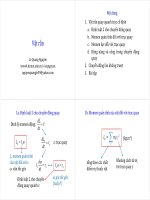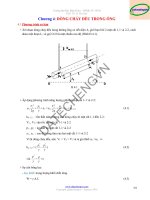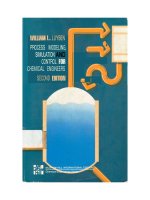Giao trinh bai tap clcbia b
Bạn đang xem bản rút gọn của tài liệu. Xem và tải ngay bản đầy đủ của tài liệu tại đây (97.49 KB, 5 trang )
Materials 286C/UCSB: Class VI — Structure factors (continued), the
phase problem, Patterson techniques and direct methods
Ram Seshadri ()
Structure factors
The structure factor for a system with many atoms, each with its own form factor fj and sitting
within the unit cell at a site with the crystallographic coordinates (uj , vj , wj ) is described by:
N
Fhkl =
fj exp[2πi(huj + kvj + lwj )]
j=1
The square of the structure factor is an indication of the intensity of any spot/peak/intensity
in the diffraction pattern corresponding to the Bragg conditions being satisfied for the particular
hkl. There are other contributors to the intensity, such as the Lorentz-polarization factors and the
Debye-Waller factor that we will discuss at a later stage.
Some applications:
CsCl
The CsCl structure is simple cubic (P m3m) with the Cs atom at the corners of a cube at (0,0,0)
and the Cl atom at ( 12 , 12 , 12 ). The structure factor for any hkl reflection is:
1
1
1
Fhkl = fCs exp[2πi(h0 + k0 + l0)] + fCl exp[2πi(h + k + l )]
2
2
2
which simplifies to
Fhkl = fCs + fCl exp[πi(h + k + l)]
When
(h + k + l) is even, exp[πi(h + k + l)] = 1 and when (h + k + l) is odd, exp[πi(h + k + l)] = −1
This means, for CsCl:
Fhkl =
fCs + fCl , if (h + k + l) is even;
fCs − fCl , if (h + k + l) is odd
For an hcp metal
The atoms are at (0,0,0) and ( 31 , 23 , 12 ), and both atoms have a form factor f :
1
2
1
Fhkl = f + f exp[2πi(h + k + l )]
3
3
2
We consider specific cases:
F001 = f + f exp[πi] = f − f = 0
1
F002 = f + f exp[2πi] = f + f = 2f
F100
√
2πi
1
3
= f + f exp[
] = f + if
3
2
2
√
1 1
3
3
F101 = f + f exp[2πi( + )] = f − if
3 2
2
2
The corresponding intensities are obtained from
∗
Ihkl = Fhkl · Fhkl
Thus
I001 = 0; I002 = 4f 2 , I100 = f 2 , I101 = 3f 2
The Argand diagram can be used to graphically represent Fhkl :
f
F002
F100
φ
2π 3
✁
F101
φ
5π 3
✁
2
Diffraction from a centrosymmetric crystal
In a centrosymmetric crystal, (u, v, w) and (−u, −v, −w) represent the same point. Note that
negative numbers are also written with overlines: −u = u. In other words, for any atom with form
factor f at the position (u, v, w), there is an identical atom at (u, v, w). Together, the structure
factor due to these is:
Fhkl = f exp[2πi(hu + kv + lw)] + f exp[2πi(hu + kv + lw)]
= f exp[2πi(hu + kv + lw)] + f exp[−2πi(hu + kv + lw)]
Now exp(iφ) + exp(−iφ) = cos φ + i sin φ + cos φ − i sin φ = 2 cos φ
This means that for a centrosymmetric crystal,
Fhkl = 2f cos[2π(hu + kv + lw)]
Friedel’s Law
Friedel’s law states that even if a crystal does not possess a center of symmetry, it’s diffraction
pattern does.
∗
Ihkl = Fhkl · Fhkl
= f exp[2πi(hu + kv + lw)] × f exp[−2πi(hu + kv + lw)]
= f exp[2πi(hu + kv + lw)] × f exp[2πi(hu + kv + lw)]
By the same token,
∗
= f exp[2πi(hu + kv + lw)] × f exp[−2πi(hu + kv + lw)]
Ihkl = Fhkl · Fhkl
= f exp[2πi(hu + kv + lw)] × f exp[2πi(hu + kv + lw)]
In other words:
∗
∗
Fhkl = Fhkl
and Fhkl
= Fhkl
and Ihkl = Ihkl .
Friedel’s law is violated in the case when diffraction is anomalous.
The phase problem
Simply stated, what is measured in an experiment is Ihkl , but what is required is Fhkl . There is no
information of phase in Ihkl .
3
Inverting the structure factor equation
Since the atomic form factor is a reflection of the electron density, one could write a the expression
for the structure factor in continuous form (rather than for discrete points):
ρ(xyz) exp[2πi(hx + ky + lz)
Fhkl =
cell
where ρ(xyz) represents the electron density at point (xyz) in the unit cell and the integration is
performed for all points in the cell.
Assume that Fhkl can be measured. Then ρ(xyz) can be obtained through the Fourier transform
of Fhkl .
ρ(xyz) =
1
V
Fhkl exp[−2πi(hx + ky + lz)]
where V is the volume of the unit cell. One could write this as the summation:
ρ(xyz) =
1
V
Fhkl exp[−2πi(hx + ky + lz)]
h,k,l
But we remember that the vector Fhkl can be written in terms of its amplitude and phase:
Fhkl = |Fhkl | exp[iφ(hkl)]
where φ(hkl) is the phase associated with the point in reciprocal space associated with the coordinates (hkl). This means
ρ(xyz) =
1
V
|Fhkl | exp[iφ(hkl)] exp[−2πi(hx + ky + lz)]
h,k,l
The structure factor has units of electrons and the density ρ(xyz) has units of electrons ˚
A−3 .
The summation is over all h, k and l values. The summation must be carried out on as fine a grid
of x, y and z points as possible to obtain a smooth electron density distribution in the unit cell.
Where the electron density is concentrated, atoms are found.
Solving a crystal structure
Assume you have a crystal about which you know nothing. This crystal diffracts X-rays and you
collect as complete a 3D set of diffraction data as possible. The question is whether the diffraction
data has all the information necessary to completely determine the structure of the crystal. Can the
diffraction pattern be used to locate all atoms in the unit cell, and their identities established. The
answer is yes, at least in most cases. This despite the fact that phase information is not available
in the diffraction pattern.
Two methods are commonly used to get around the phase problem. The first is the use of
so-called Patterson synthesis and the second, more widely used class of tools are referred to as
Direct Methods.
4
Patterson synthesis
The Fourier transform (FT) of the observed diffraction beam amplitudes |F | gives the correct
electron density, but it requires a knowledge of the phases of all the reflections. The FT of the
squared amplitudes |F |2 with all phases set to zero is called the Patterson function/synthesis/map:
P (xyz) =
1
V
|Fhkl |2 exp[−2πi(hx + ky + lz)]
h,k,l
All information required to produce such a transform is available from experimental data.
The Patterson function is periodic and looks just like one might expect the electron density to
look. The peaks in the Patterson are not peaks in the electron density. Instead, they correspond to
a mapping of vectors between pairs of atoms. For every pair of atoms at the positions (x1 , y1 , z1 ) and
(x2 , y2 , z2 ), there are equal peaks in the Patterson map at the the position (x1 − x2 , y1 − y2 , z1 − z2 )
and (x2 − x1 , y2 − y1 , z2 − z1 ). The relative sizes of the Patterson peaks are proportional to the
square of the atomic numbers at the two sites.
In the Patterson map, the strongest peaks are always at the origin, corresponding to vectors
between atoms and themselves. If there are n atoms, there are n2 − n other peaks. Many of these
are difficult to resolve. If there are a few heavy atoms in the structure however, these form pairs
that give rise to strong peaks and their positions can be guessed.
Once heavy atoms are located, one can calculate the forward Fourier transform (which is precise)
to obtain a set of calculated structure factors: Fhkl,calc . These are compared with the observed
structure factors Fhkl and the model is improved using an iterative procedure.
Direct methods
In direct methods, a few strong Ihkl are chosen and their phases are assigned at random. Then relationships between the phases are sought for, and the phases constantly modified until a consistent
set is obtained. This allows initial Fhkl,calc to be obtained. The structure is improved thereon.
5









